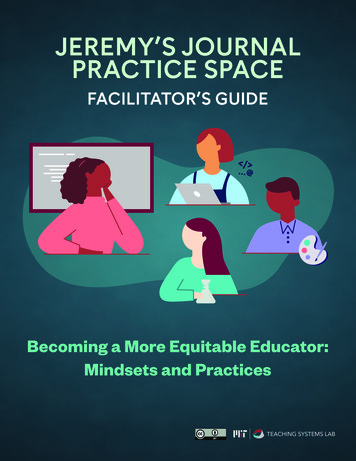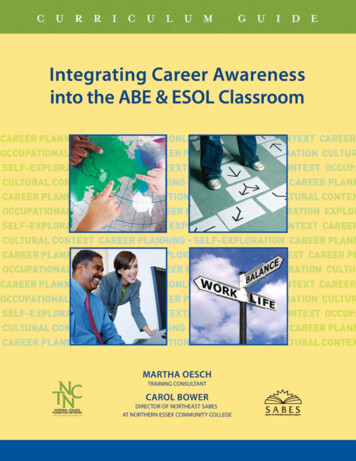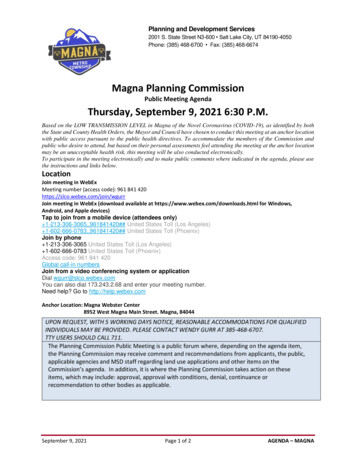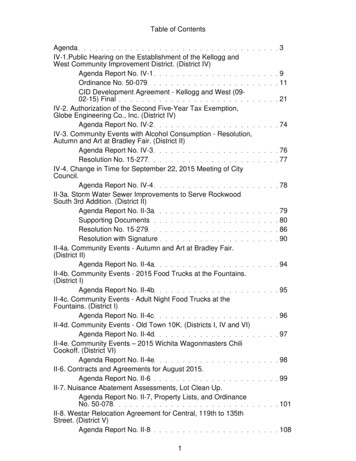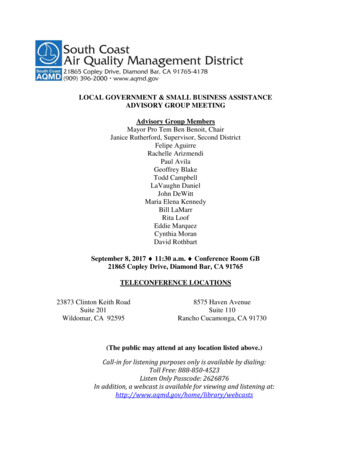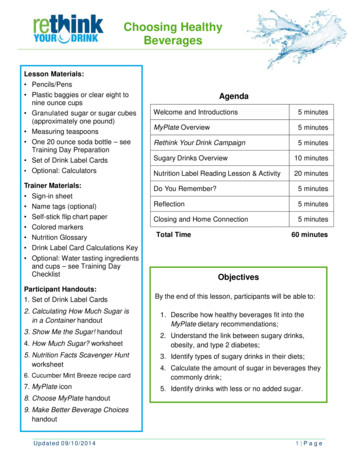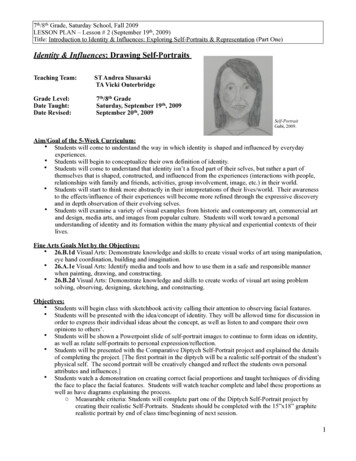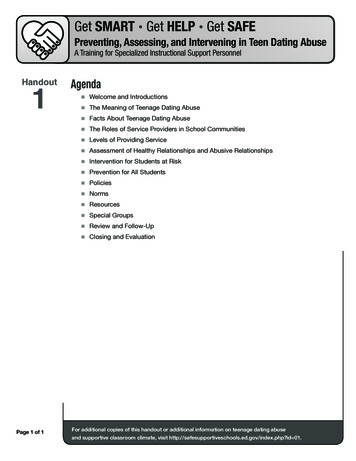
Transcription
Get Smart Get Help Get SafePreventing, Assessing, and Intervening in Teen Dating AbuseA Training for Specialized Instructional Support PersonnelHandout1Page 1 of 1AgendannWelcome and IntroductionsnnThe Meaning of Teenage Dating AbusennFacts About Teenage Dating AbusennThe Roles of Service Providers in School CommunitiesnnLevels of Providing ServicennAssessment of Healthy Relationships and Abusive RelationshipsnnIntervention for Students at RisknnPrevention for All StudentsnnPoliciesnnNormsnnResourcesnnSpecial GroupsnnReview and Follow-UpnnClosing and EvaluationFor additional copies of this handout or additional information on teenage dating abuseand supportive classroom climate, visit http://safesupportiveschools.ed.gov/index.php?id 01.
Get Smart Get Help Get SafePreventing, Assessing, and Intervening in Teen Dating AbuseA Training for Specialized Instructional Support PersonnelHandout2Teen Power and Control WheelBuilding Safe Schools: A Guide to Addressing Teen Dating Violence—A Resource Manual for School EmployeesBreak the Cycle: Empowering Youth to End Domestic pdf/ta-teacher-manual.pdfPage 1 of 1For additional copies of this handout or additional information on teenage dating abuseand supportive classroom climate, visit http://safesupportiveschools.ed.gov/index.php?id 01.
Get Smart Get Help Get SafePreventing, Assessing, and Intervening in Teen Dating AbuseA Training for Specialized Instructional Support PersonnelHandout3Page 1 of 1Why You Are NeedednnYou communicate well with students.nnYou respect students.nnYou have knowledge of students’ issues.nnYou are aware of cultural biases.nnYou recognize when students are in trouble.nnYou know what to do in case of an emergency.nnYou can work with the entire school community, including administrators,staff, students, and their families.nnYou have the information and skills to help students work through conflicts.For additional copies of this handout or additional information on teenage dating abuseand supportive classroom climate, visit http://safesupportiveschools.ed.gov/index.php?id 01.
Get Smart Get Help Get SafePreventing, Assessing, and Intervening in Teen Dating AbuseA Training for Specialized Instructional Support PersonnelHandout4Signs of a Healthy RelationshipnnShared enjoyable experiencesnnControl of angernnResolution of conflicts without violencennAdjustment to stressnnOpen and honest communicationnnShared decision makingnnBelief in own and other’s autonomynnTrustnnRespectnnCompromisennEmpathy and caringAdapted from Dating Matters: Understanding Teen Dating Violence Preventionwww.vetoviolence.org/datingmattersPage 1 of 1For additional copies of this handout or additional information on teenage dating abuseand supportive classroom climate, visit http://safesupportiveschools.ed.gov/index.php?id 01.
Get Smart Get Help Get SafePreventing, Assessing, and Intervening in Teen Dating AbuseA Training for Specialized Instructional Support PersonnelHandout5Signs of an Abusive RelationshipSome signs may be obvious:nnOne student in the relationship always seems to be controlling the other,either physically, emotionally, or verbally.nnOne student in the relationship has unexplained bruises.nnOne student in the relationship always defers to the other.But look beyond the obvious toward the following school-focused behaviors:nnA drop in attendancennA drop in gradesnnRequests for schedule changesAnd consider whether the student has displayed the following:nnIsolation from former friendsnnLoss of interest in activitiesnnLoss of self-confidencennSudden weight changeNone of these signs by themselves may indicate an abusive relationship (and the signs maybe symptoms of other concerns as well), so look at them as a whole.Adapted from Dating Matters: Understanding Teen Dating Violence Preventionwww.vetoviolence.org/datingmattersPage 1 of 1For additional copies of this handout or additional information on teenage dating abuseand supportive classroom climate, visit http://safesupportiveschools.ed.gov/index.php?id 01.
Get Smart Get Help Get SafePreventing, Assessing, and Intervening in Teen Dating AbuseA Training for Specialized Instructional Support PersonnelHandout6Getting Information to Assess RisknnHas the student been humiliated?nnHas the student been isolated?nnHave the student’s actions—who to see, what to do—been controlled?nnHas the student been physically violated (e.g., punched, shoved, kicked, slapped,or choked)?nnHas the student been sexually abused?nnHas the student (or the student’s friends or family) been threatened?nnHas the student been defamed over the Internet?nnHas the student been receiving excessive phone calls or texts that are abusive,offensive, threatening, or unwanted?nnHas the student been constantly questioned about activities and other relationships?nnHas the student been continually insulted?nnHas the student been continually manipulated?Adapted from Dating Matters: Understanding Teen Dating Violence Preventionwww.vetoviolence.org/datingmattersPage 1 of 1For additional copies of this handout or additional information on teenage dating abuseand supportive classroom climate, visit http://safesupportiveschools.ed.gov/index.php?id 01.
Get Smart Get Help Get SafePreventing, Assessing, and Intervening in Teen Dating AbuseA Training for Specialized Instructional Support PersonnelHandout7Why Teenagers Don’t Get Help1. “I love him, even if sometimes I hate what he does. I don’t want to lose him.”2. “She loves me, even if sometimes she has a bad day and things get a little outof hand.”3. “It might take some time, but I know I can change him.”4. “A guy being pushed around by a girl? If anyone knew about this,I’d die of embarrassment.”5. “It’s not that bad. Other people have it worse.”6. “It’s my fault. I don’t want to blame him for my failings.”Page 1 of 2
7. “I’m afraid of what she’ll do if she knows I told someone.”8. “It’s better to be with him than to be alone.”9. “If my parents found out about this, they’d ground me until I was 40.”10. “People get what they deserve. I must deserve this.”11. “I’ve talked with my friends about it; they assured me that things would get betterand that I should get used to it.”12. “I have no idea who can help me.”Page 2 of 2For additional copies of this handout or additional information on teenage dating abuseand supportive classroom climate, visit http://safesupportiveschools.ed.gov/index.php?id 01.
Get Smart Get Help Get SafePreventing, Assessing, and Intervening in Teen Dating AbuseA Training for Specialized Instructional Support PersonnelHandout8Do and Don’t: Responding to a Student Who Isin an Abusive RelationshipWhat to say:nn“I’m glad you told me about this.”nn“This is important.”nn“I want you to be safe.”nn“Let’s make sure you get the help you need right now.”nn“It’s not your fault.”nn“You deserve to be treated with respect in your relationship.”nn“I’m here if you ever need help or want to talk.”What to do:Page 1 of 2nnListen.nnBe honest about your ability to keep information confidential; consider yourprofessional “code of conduct.”nnBe specific in your concerns, especially if you’ve seen abusive behaviors.nnAsk questions.nnChallenge the student to see the warning signs in his or her relationship.nnTo the extent possible, given safety concerns, allow the student to make his orher own decisions about the relationship.nnTell the student what you’re required to do under the law or school policy.nnProvide information on local resources.nnDevelop an “action plan” with the student.nnContinue to check in with the student throughout the school year and beyond.
But:nnDon’t be judgmental about the student’s relationship or choices.nnDon’t try to take control of the situation, unless an emergency requires you to do so.nnDon’t ignore the red flags you see.nnDon’t make assumptions about how the student wants to handle the relationship.nnDon’t minimize the abuse or the importance of the relationship.nnDon’t assume that because the relationship is new or casual, the abuse is minor.nnDon’t assume that the student is heterosexual.nnDon’t share a student’s private information with people unnecessarily or talk aboutstudents in public areas of the school.nnDon’t show shock or disapproval if the student tells you about his or hersexual activities.nnDon’t blame the student for remaining in the relationship.Adapted from Building Safe Schools: A Guide to Addressing Teen Dating Violence—A Resource Manual for School EmployeesBreak the Cycle: Empowering Youth to End Domestic pdf/ta-teacher-manual.pdfPage 2 of 2For additional copies of this handout or additional information on teenage dating abuseand supportive classroom climate, visit http://safesupportiveschools.ed.gov/index.php?id 01.
Get Smart Get Help Get SafePreventing, Assessing, and Intervening in Teen Dating AbuseA Training for Specialized Instructional Support PersonnelHandout9Working With the Alleged PerpetratorSchools should make every reasonable effort to protect the due process rights of the allegedperpetrator and the safety of the victim. Schools should consider adopting the followingmethods of intervention with the alleged perpetrator:nnHold a conference with the alleged perpetrator and parent or guardian.nnAllow the alleged perpetrator an opportunity to respond in writing to the allegations.nnEmphasize expectations for positive behavior.nnIdentify and implement disciplinary and other actions and consequences that will betaken to prevent further incidents.nnInform the alleged perpetrator and parent or guardian of help and support available atthe school or in the community as needed.nnAddress the seriousness of retaliation against the victim for reporting the incident orcooperating with the investigation.nnIncrease supervision of the alleged perpetrator as needed.nnDocument the meeting and action plans on a complaint form.Adapted from Building Safe Schools: A Guide to Addressing Teen Dating Violence—A Resource Manual for School EmployeesBreak the Cycle: Empowering Youth to End Domestic pdf/ta-teacher-manual.pdfPage 1 of 1For additional copies of this handout or additional information on teenage dating abuseand supportive classroom climate, visit http://safesupportiveschools.ed.gov/index.php?id 01.
Get Smart Get Help Get SafePreventing, Assessing, and Intervening in Teen Dating AbuseA Training for Specialized Instructional Support PersonnelHandout10School-Based Stay-Away AgreementThe intent of this agreement is to increase safety for students who have been the targetof repeated bullying, sexual harassment, or dating violence. It is to be administered by theprincipal or the principal’s designee in a conference with the offending student and his orher parent or guardian.Name of student:Date of most serious incident:Description of behaviors involved in incident:Date of assessment by principal or designee:Date of parent notification:This agreement is being administered because (name of school) has found that (name ofalleged offender) has committed an abusive act. In order to protect the rights and safety ofall members of our school community, you are required to stay away from (name of targetedstudent) at all times during the school day and at any school-sponsored event. This meansthat you may not approach, talk to, sit by, or have any contact with (name of targetedstudent) at school or on school property, school buses, and bus stops.In addition, the following actions are effective immediately (list schedule changes,disciplinary, or restitution actions):Page 1 of 2
Current schedule:New schedule:Other disciplinary actions:Violations of this agreement and acts of retaliation directly or indirectly toward the targetor the target’s friends or family members will be taken seriously and will result in furtherdisciplinary actions. Your compliance will be monitored by (name and title of school staff).This agreement is valid from (date) to (date).This agreement will be reviewed on (date).Signatures:Student: Date:Parent/Guardian: Date:Administrator: Date:This document will be shared with all staff, faculty, and administration of (name of school).Austin Independent School District, TexasStudent Welfare: Freedom From Harassmentwww.ncdsv.org/images/AISD ct 2010-11.pdfPage 2 of 2For additional copies of this handout or additional information on teenage dating abuseand supportive classroom climate, visit http://safesupportiveschools.ed.gov/index.php?id 01.
Get Smart Get Help Get SafePreventing, Assessing, and Intervening in Teen Dating AbuseA Training for Specialized Instructional Support PersonnelHandout11Social Workers and “Duty to Warn” State LawsIntroductionSocial workers often inquire about their duty to report threats of harm that they learn about inthe course of a professional relationship with a client. A prior LDF (Legal Defense Fund) LegalIssue of the Month article, Social Workers and the Duty to Warn, reviewed court decisions thathave addressed this topic; however, many states have passed duty-to-warn legislation and thespecific contours of the duty to warn are defined on a state by state basis. This Legal Issue ofthe Month article focuses on the state statutes relating to the social workers’ duty to warn.BackgroundTarasoff v. Regents of the University of California (1976) is the landmark case that establishedthe duty to warn in California and its reasoning has been applied to establish a duty to warnin states across the country. Generally, a therapist’s duty to warn is based on what the courtsview as a “special relationship” established between the treating clinician and the patient whois in need of mental health treatment.By accepting responsibility for the care of a client in need of mental health treatment, theclinical social worker may owe a duty to protect third parties from harm threatened by theclient. The court in Tarasoff found, “When a therapist determines, or pursuant to the standardsof his profession should determine, that his patient presents a serious danger of violence toanother, he incurs an obligation to use reasonable care to protect the intended victim againstsuch danger” (Tarasoff, 1976, p. 340). Generally, the duty applies to situations where the clientidentifies himself as the potentially dangerous person. Thus, it would not generally apply wherea client discloses in therapy that a third party intends to harm another third party.Duty to Warn—State VariationsMandatory Duty to WarnMany social workers are unaware that duty to warn laws vary from state to state andthat a few states have not established a statutory duty to warn. Twenty-two states havestatutes applicable to social workers that establish a mandatory duty to warn. Theseare: Arizona, California, Colorado, Delaware, Idaho, Illinois, Indiana, Kentucky, Louisiana,Maryland, Massachusetts, Michigan, Minnesota, Montana, Nebraska, New Hampshire,New Jersey, Ohio, Tennessee, Utah, Virginia, and Washington. A number of these statesalso have court decisions that have interpreted the duty to warn laws.Page 1 of 4
“Permissive” StandardA second group of states give permission in state statutes for social workers to warn ofserious threats. These states are: Alaska, Arkansas, District of Columbia, Florida, Hawaii,Iowa, Mississippi, Missouri, New Mexico, New York, Oklahoma, Oregon, Rhode Island, SouthCarolina, South Dakota, Texas, Virgin Islands, West Virginia, and Wyoming. In some states,such as Texas, the permission to warn is limited to notifying medical or law enforcementpersonnel, not the threatened person or persons.No Statutory StandardA third set of states does not provide any statutory language for social workers addressingthe duty to warn, but some of these have implemented the duty through court decisions.Connecticut, Pennsylvania, Vermont and Wisconsin do not have statutory provisions, buthave established a duty to warn through court decisions. States that are silent as to the socialworker’s duty to warn are Georgia, Kansas, Maine, Nevada, North Dakota, and Puerto Rico.A small number of states have statutory language or court decisions that may be interpretedas limiting the duty to warn. These include: Alabama (King v. Smith, 539 So.2d 262 (1989),Guam (statute) and North Carolina (Gregory v. Kilbride, 150 N.C.App. 601 (2002)).Type of Threat and DutyStates that have established a duty to warn also vary as to what type of threat triggersthe duty. Some states require or permit a disclosure of confidential information to preventa general threat to the public at large (e.g. Wisconsin, Delaware, Washington, Nebraska)(NASW, 2005), while other states require or permit disclosure based only on the basis of athreat to harm a specific individual or group of individuals (e.g. Arizona, Colorado, Louisiana,Michigan, Missouri, Vermont and New Jersey) (NASW, 2005; Polowy and Gorenberg, 1997).The attached chart (“Type of Threats that Trigger the Duty to Warn”) indicates how statestatutes have identified the events that may trigger a duty to warn.The necessary actions required to discharge the duty to warn also vary from state to state.For example, in California (2007) the duty is discharged when the therapist makes reasonableefforts to communicate the threat to the victim and to law enforcement while Delaware law(2007) provides that the therapist may notify law enforcement and the victim or arrange for thehospitalization of the patient as an acceptable means of discharging the duty to warn. Manystates do not designate the acceptable mode of intervention, thus leaving the social workerin a position of determining the most appropriate contact to prevent harm while limiting thedisclosure to the smallest number of persons.Page 2 of 4
Analysis and ConclusionsSocial workers often have responsibility for making difficult determinations regarding theassessment and treatment of clients, including taking steps to assure their safety and thatof others. Some of the key issues for clinical social workers to review in a case involvinga possible duty to warn are:nnWhether the client is the individual who represents a threat to self or othersnnWho has disclosed the threat and under what circumstancesnnHow much time has passed since the threat was madennWhether the client possesses the means and capacity to carry out the threatnnWhether the duty to warn has been established as a mandatory requirementin state lawnnWhether the threat of harm is to a specific individual or represents a general threatto the public at largennWhether the criteria for involuntary commitment may applynnWhether the state permits disclosure of a threat even if it is not mandatorynnWho needs to be warned to effectively discharge the duty to warn (e.g. lawenforcement, the intended target, the Department of Motor Vehicles, a treatingphysician, a responsible family member)Social workers’ obligations to provide competent care are grounded in the ethics andstandards of the profession and are recognized in state laws and court decisions. Treatingclients at times may encompass referring them for a higher level of care, such as inpatienthospitalization, or taking steps to warn others who may be at risk of harm by clients. Socialworkers need to be aware of the legal standards in their state that pertain to the duty to warn;however, they also need to develop and maintain the professional skills necessary to makevalid assessments of client dangerousness.ReferencesCalifornia Civ. Code § 43.92 (2007).Delaware Code Ann. tit. 16 § 5402 (2007).Polowy, C. and Gorenberg, C. (1997). Client confidentiality & privileged communications,NASW General Counsel Law Note Series. Author: Washington, DC. May be ordered bycalling 1-800-638-8799, Ext. 290.Tarasoff v. Regents of the University of California, 551 P.2d 334 (1976).National Association of Social Workers (2005). Social workers and the duty to warn. NASWLegal Defense Fund Legal Issue of the Month. [Online]. Available at www.socialworkers.org/ldf/legal issue/default.aspPage 3 of 4
Type of Threats That Trigger the Duty to WarnThreat to Specific Victim Required for Duty to WarnAlaska, Arizona, California, Colorado, Delaware, Idaho, Illinois, Kentucky, Louisiana, Maryland,Massachusetts, Michigan, Minnesota, Mississippi, Montana, Nebraska, New Hampshire(includes threat to real property), New Jersey, Ohio, Oregon, Rhode Island, South Dakota,Tennessee, Utah, Virginia, Washington WyomingDuty to Warn May Be Based on Threat to the PublicDC (substantial risk of injury), Florida, Indiana, WV (imminent danger to self or others)Permission to Warn of Contemplation of Crime or Harmful ActArkansas, Hawaii (act likely to result in death or substantial bodily harm), Iowa, Missouri,New Mexico, New York, Oklahoma (includes violations of any law), South Carolina, Texas(probability of imminent harm to self or others), Virgin IslandsThe information contained in this Web site is provided as a service to members and the social work community for educationaland information purposes only and does not constitute legal advice. We provide timely information, but we make no claims,promises or guarantees about the accuracy, completeness, or adequacy of the information contained in or linked to this Website and its associated sites. Transmission of the information is not intended to create, and receipt does not constitute, a lawyerclient relationship between NASW, LDF, or the author(s) and you. NASW members and online readers should not act based onthe information provided in the LDF Web site. Laws and court interpretations change frequently. Legal advice must be tailoredto the specific facts and circumstances of a particular case. Nothing reported herein should be used as a substitute for theadvice of competent counsel.National Association of Social Workers (NASW)www.socialworkers.orgPage 4 of 4For additional copies of this handout or additional information on teenage dating abuseand supportive classroom climate, visit http://safesupportiveschools.ed.gov/index.php?id 01.
Get Smart Get Help Get SafePreventing, Assessing, and Intervening in Teen Dating AbuseA Training for Specialized Instructional Support PersonnelHandout12Suggestions for School Policies on Teenage Dating AbuseA formal, written school policy should include at least the following:nnA behavioral definition of relationship abuse and other prohibited behaviors, includingphysical, verbal, and Internet behaviorsnnA description of the consequences for the perpetratornnA description of how relationship abuse should be addressed in terms of bothcounseling, support, and discipline, including outside resourcesnnIdentification of who is responsible for resolving incidents of abusennIdentification of who needs to be notified in cases of abusennStrategies to protect victims and people reporting the abuseAdd your own ideas:Adapted from Guidelines for Schools on Addressing Teen Dating ViolenceMassachusetts Department of Elementary and Secondary Educationwww.doe.mass.eduPage 1 of 1For additional copies of this handout or additional information on teenage dating abuseand supportive classroom climate, visit http://safesupportiveschools.ed.gov/index.php?id 01.
Get Smart Get Help Get SafePreventing, Assessing, and Intervening in Teen Dating AbuseA Training for Specialized Instructional Support PersonnelHandout13Sample Written Policy Chart for SchoolsStudent Support, Career Readiness, and Adult EducationGuidelines for Schools on Addressing Teen Dating ViolenceBehaviors ThatAre Not AllowedVerbal/Nonverbal/WrittennnUse of put-downs,insults, name calling,swearing, or offensivelanguagennScreaming or yellingat eferralDocumentFirst OffenseVerbal warning/educationYes, if appropriateYes, if appropriateYes, if appropriateYesRepeat OffenseTeacher-studentconference/sendto office/detentionInformInformDating orother violencepreventioncounselorYesFirst OffenseDetention/education/suspensionMust informParent conferenceYesDating or otherviolence protectioncounselor/schoolsecurity/policeRepeat OffenseDetention smentMust informParent conferenceYesnnMaking threats, beingintimidating, or gettingfriends to threatenor scare anotherPhysicalnnHitting, punching,pinching, pushing,shoving, grabbing,slapping, kicking,choking, pulling hair,biting, throwing things,or arm twistingnnIntimidation, blockingexits, punching walls, orknocking things aroundnnDamaging or destroyinganother’s propertynnRestraining, pinningsomeone to the wall,blocking someone’smovementsPage 1 of 2Using WeaponsSuspension/expulsionMust informMust informPoliceYesStalkingSuspension/expulsionMust informMust informPoliceYes
Behaviors ThatAre Not irst OffenseDetention/education/suspensionMust informParent conferenceRepeat OffenseSuspension/psychologicalassessmentMust informParent conferencebefore admittanceForcing obscenematerials on othersSuspension/expulsionMust informMust informPoliceYesPulling off or liftingclothes to exposeprivate partsSuspension/expulsionMust informMust informPoliceYesRape or attempted rapeSuspension/expulsionMust informMust informPoliceYesSexualnnName calling, such asslut, bitch, or fagnnCatcalls or otheroffensive noisesor whistlingnnSpreading sexualgossip or graffitiReferralDocumentSexual harassment Yescounselor/datingviolence or rapecounselor/schoolsecurityYesnnComments abouta person’s body orunwanted verbalor written sexualcommentsnnStaring or leeringwith sexual overtones,sexual gesturesGuidelines for Schools on Addressing Teen Dating ViolenceMassachusetts Department of Elementary and Secondary Educationwww.doe.mass.eduPage 2 of 2For additional copies of this handout or additional information on teenage dating abuseand supportive classroom climate, visit http://safesupportiveschools.ed.gov/index.php?id 01.
Get Smart Get Help Get SafePreventing, Assessing, and Intervening in Teen Dating AbuseA Training for Specialized Instructional Support PersonnelHandout14Changing NormsYou’re in a unique position to establish and maintain positive norms in a school community.The question is, how do you go about doing that?Here are some ideas, particularly for establishing and maintaining positive norms concerningteenage dating abuse:1. Enlist peer leaders.nn Determine—for example, through a schoolwide survey—the peer leaders amongstudents. Which students do the athletes look to for advice or information?Which students do the music students look to? How about the science students?The various ethnic groups? The various social groups?nn Once you’ve identified the peer leaders, invite them to a special session onpreventing teenage dating abuse. Give them information about the issue—whatit looks like, what effects it has, and why some people in such relationships maybe reluctant to get help.nn Let the students know that they’re in a position to influence their peers’ behavioreither positively or negatively and that you’re counting on them to do the former.Give them strategies to do that, e.g., speaking at student gatherings, modelingsafe and healthy behavior, and urging students who may be in unhealthyrelationships to see the appropriate school personnel.nn Be sure to tell students that they’re not professional counselors and that ifsomeone is in an unsafe situation, they should not be bound by promises ofsecrecy; they should get help immediately, even at the cost of a friendship.2. Hold informational assemblies for all students.nn Give students information about the incidence and seriousness of teenage datingabuse. Incorporate either written or oral testimony from teenagers—perpetratorsas well as victims—who have experienced it. Be careful, however, about exposingstudents to more harassment or stigma than they might be initially aware of.nn Identify the signs of abuse.nn Be sure that students know where and how to get help.nn Promote the idea of students helping each other.3. Facilitate meetings with family members to inform them of the issue.nn Give them information about the incidence and seriousness of teenage datingabuse. Incorporate either written or oral testimony from teenagers—perpetratorsas well as victims—who have experienced it.nn Identify the signs of abuse.nn Be sure that family members know where and how to get help—both in andoutside the school.nn Encourage them to talk to their children about the issue.Page 1 of 2
4. Facilitate meetings with coaches, teachers, club sponsors, and representativesof other groups who have influence over students.nn Give them information about the incidence and seriousness of teenage datingabuse. Incorporate either written or oral testimony from teenagers—perpetratorsas well as victims—who have experienced it.nn Identify the signs of abuse.nn Be sure that they know where and how to get help—both in and outside the school.nn Let them know that students frequently look to them for support and that you’recounting on them to offer accurate information and helpful advice. Give themstrategies to do that, e.g., speaking at student gatherings, modeling safe andhealthy behavior, and urging students who may be in unhealthy relationshipsto see the appropriate school personnel.nn Be sure to tell them that they’re not professional counselors and that if a studentis in an unsafe situation, they should not be bound by promises of secrecy; theyshould get help immediately.5. Coordinate with the larger community (e.g., police, business, athletic organizations,social services
Feb 27, 2013 · For additional copies of this handout or additional information on teenage dating abuse and supportive classro
